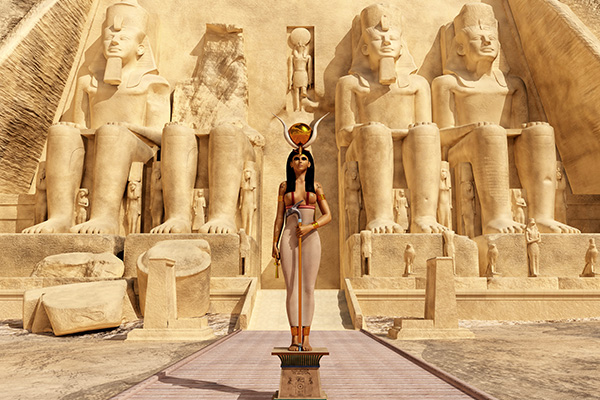mythology
The Timeless Magic Of Nature Spirits And Elementals
 As a youngster growing up in the UK, I loved visiting a neighbor, Mrs. O’Leary, whose lilting Irish voice still echoes in my mind. She spoke often of the “Good People” and acknowledged their presence in her home and garden. I recall her taking us outside to witness her making small offerings to these unseen little mystical beings.
As a youngster growing up in the UK, I loved visiting a neighbor, Mrs. O’Leary, whose lilting Irish voice still echoes in my mind. She spoke often of the “Good People” and acknowledged their presence in her home and garden. I recall her taking us outside to witness her making small offerings to these unseen little mystical beings.
Though it feels like a distant memory now, I can still recall seeing them, too. Perhaps they appeared to us because we truly believed, or perhaps because Mrs. O’Leary invited them to show themselves.
Whatever the reason, those moments left a lasting impression. To me, it felt like truly being “in my element,” fully connected to the hidden, magical forces of nature.
I vaguely recall a magical moment in Mrs. O’Leary’s garden when she pointed out to me a tiny, translucent little figure perched on a large moss-covered rock at the base of her prized old hawthorn tree. With delight, she described how this “little person” was waving at us and encouraged me to wave back. Standing there with awe and intrigue, I became aware of what seemed like hundreds of luminous sprites dancing in the glistening water below.
Despite all the cynicism of a technologically driven world, increasingly devoid of the many miracles and wonders of nature and the unseen realms, Mrs. O’Leary and the spirits of nature still remind me of the healing, transformative power that lies in reverence, stillness, and everyday magic.
Awakening To A New Age Of Higher Dimensions
 Many of us have been gradually becoming aware of a different kind of reality in recent years. Things that were once hidden, both good and bad, are now exposed for many of us to see.
Many of us have been gradually becoming aware of a different kind of reality in recent years. Things that were once hidden, both good and bad, are now exposed for many of us to see.
Since the new millennium began, and especially in the last ten years, more and more of us have started to feel a deeper connection to a higher power and a growing desire to align with God, Spirit, and the Divine. At the same time, we are also becoming more aware of negative and dark energies that were always present, but are now obvious and undeniable.
This worldwide change is known as the Ascension, the Shift, or the New Earth paradigm. It is a significant shift in energy and awareness. It is also known as 5D consciousness, the Age of Aquarius, or the Great Awakening.
It is a deeply personal change of moving towards unity, love, and a higher level of awareness, and away from negative, fear-based energies of a lower level of awareness.
I’ve seen enough of the negative effects of these lower vibrations in my work to know how draining and soul-destroying it can be. I plan to keep moving with the tides of this new, higher vibrational frequency, which includes not buying into the fear, drama and negativity. It also means keeping an open heart and mind.
We are living in a time of conscious evolution. We are slowly moving from the third-dimensional existence, where duality, time, and materialism remain the focus, to a fifth-dimensional reality, where love, unity, and higher consciousness.
What I Learned From Egyptian Goddess Hathor
 From the moment I first encountered her, Hathor, the ancient Egyptian goddess, she felt like a luminous companion on my spiritual path.
From the moment I first encountered her, Hathor, the ancient Egyptian goddess, she felt like a luminous companion on my spiritual path.
To me she isn’t just a myth or a symbol. She’s a living presence and a spiritual guide. She’s also a gentle yet powerful presence in my psychic and healing work. Her energy speaks to me on a deeply intuitive level.
My connection with Hathor began unexpectedly while reading a book on ancient Egypt. Suddenly, I felt a comforting warmth surround me. It was as if a long-lost friend had returned.
Then, I was guided to raise my hands, palms facing outward and I sensed her hands and palms facing mine. A glow of golden light flashed before me and I felt a warm sensation entering my palms and almost as though my hands were being supported and held, and all time was suspended.
In that timeless and powerful moment, Hathor’s nurturing love enveloped me, and her ancient wisdom whispered that time is merely a construct.
In the Infinite Light, there is no past or future, only this sacred now. In is in the present moment that healing and miracles unfold.
As a psychic, I find that Hathor naturally aligns with my practice. She is not just the goddess of love and beauty, though she radiates both. She embodies a vibrant, nurturing energy that opens emotional and spiritual channels.
A Beginner’s Guide To Astral Projection
 Every spiritual tradition speaks of a world beyond our own — an ethereal realm that exists just beyond the veil of the physical senses. Whether it’s Nirvana in Buddhism, Asgard in Norse mythology, or the Elysian Fields of the ancient Greeks, these higher dimensions are seen as places of transcendence and divinity.
Every spiritual tradition speaks of a world beyond our own — an ethereal realm that exists just beyond the veil of the physical senses. Whether it’s Nirvana in Buddhism, Asgard in Norse mythology, or the Elysian Fields of the ancient Greeks, these higher dimensions are seen as places of transcendence and divinity.
Traditionally, such realms are associated with the afterlife, but that’s only part of the story. The truth is that we don’t have to die to access them. These higher planes of existence can be explored while we are still very much alive.
While mystics, shamans, and seers have spoken of these realms for millennia, modern science, particularly in the fields of quantum theory and consciousness studies, is beginning to acknowledge the possibility of multiple dimensions, parallel realities, and alternate timelines. Phenomena such as déjà vu or lucid dreaming, for example, may be brief collisions between timelines or conscious overlaps with other dimensions where versions of ourselves already exist.
So how do we consciously access these mystical realms? The practice of astral projection — also known as astral travel, out-of-body experiences, or lucid voyaging — is one way to do just that.
The idea of consciously traveling beyond the physical body has appeared in various cultures and spiritual traditions throughout history. Although interpretations vary, many civilizations have incorporated the concept into their myths, religious practices, and mystical philosophies.
Embrace The Wisdom Of Your Inner Crone
 The archetypes of the Maiden, the Mother, and the Crone are central figures in various spiritual and mythological traditions, especially in Paganism and Wicca, where they represent the Triple Goddess. They symbolize the three primary phases of a woman’s life and the cycles of nature, and are associated with the phases of the moon — waxing, full, and waning.
The archetypes of the Maiden, the Mother, and the Crone are central figures in various spiritual and mythological traditions, especially in Paganism and Wicca, where they represent the Triple Goddess. They symbolize the three primary phases of a woman’s life and the cycles of nature, and are associated with the phases of the moon — waxing, full, and waning.
The Maiden is associated with the waxing moon, representing youth, new beginnings, potential, and innocence; the Mother aligns with the full moon, embodying creation, fertility, abundance, and maturity; and the Crone is associated with the waning moon, symbolizing wisdom, life experience, reflection, and endings that lead to new beginnings.
In Greek mythology, these archetypes are seen in the Moirai or Fates: Clotho (the spinner of the thread of life), Lachesis (the measurer), and Atropos (the cutter). Similarly, in Hinduism, the goddess Kali represents the transformative power of the Crone, who presides over destruction and rebirth. They remind us of the cyclical nature of existence and the interconnectedness of the stages of life.
Mary, the mother of Jesus, embodies the essence of the Crone within the Christian tradition. As Mater Dolorosa (Sorrowful Mother), she is revered as a figure of profound strength and resilience, having witnessed the suffering and death of her Son. Her wisdom, born of enduring immense grief and unwavering faith, serves as a beacon of strength and compassion for the faithful. She is seen as a compassionate and empathetic figure who understands human suffering and intercedes for believers with her love and wisdom.
Inner Journey To The Mystical Isle Of Avalon
 Sometimes when the pressures and demands of modern life become too much, I retreat to one of my favorite places in the universe: the mythical island of Avalon.
Sometimes when the pressures and demands of modern life become too much, I retreat to one of my favorite places in the universe: the mythical island of Avalon.
This legendary island of Celtic mythology is steeped in legends of healing, psychic learning, sacred crafting, and the life and times of King Arthur. Its name translates as “Isle of Apples,” emphasizing its association with fertility, abundance, and otherworldly beauty.
In folklore, Avalon, or Insula Avallonis, was a sanctuary of deep spiritual and psychic knowledge and was known as a training ground for pagan priestesses dedicated to the Great Mother Goddess. These women dedicated their lives to spirituality, honing their skills in clairvoyance, herbalism, weaving, and deep devotion to the Divine Feminine.
But Avalon was not only a sanctuary for women. Men were also an integral part of its story. Merlin the magician is inextricably linked to the history of the island, having trained the young Arthur there for his kingship.
Avalon is also entwined with many other tales woven through the lives of King Arthur, Guinevere, Morgan le Fay, Merlin, Nimue (the Lady of the Lake), and others. Legend also has it that King Arthur was brought to Avalon by his half-sister, Morgan le Fay, to heal after being badly wounded in battle.
The question of whether Avalon really existed straddles the line between myth and reality. Some historians and researchers speculate that Avalon may be based on a real place. Glastonbury, England, is often associated with Avalon because of its mystical aura and ties to Arthurian legend.
